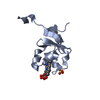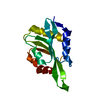[English] 日本語
 Yorodumi
Yorodumi- PDB-2las: Molecular Determinants of Paralogue-Specific SUMO-SIM Recognition -
+ Open data
Open data
- Basic information
Basic information
| Entry | Database: PDB / ID: 2las | ||||||
|---|---|---|---|---|---|---|---|
| Title | Molecular Determinants of Paralogue-Specific SUMO-SIM Recognition | ||||||
 Components Components |
| ||||||
 Keywords Keywords |  TRANSCRIPTION / TRANSCRIPTION /  RanBP2 / RanBP2 /  post-translational modification post-translational modification | ||||||
| Function / homology |  Function and homology information Function and homology informationcytoplasmic periphery of the nuclear pore complex / SUMO ligase activity / SUMO ligase complex / negative regulation of transcription by transcription factor localization / annulate lamellae / SUMOylation of nuclear envelope proteins / Negative regulation of activity of TFAP2 (AP-2) family transcription factors / SUMO is proteolytically processed / negative regulation of delayed rectifier potassium channel activity / SUMO is conjugated to E1 (UBA2:SAE1) ...cytoplasmic periphery of the nuclear pore complex / SUMO ligase activity / SUMO ligase complex / negative regulation of transcription by transcription factor localization / annulate lamellae / SUMOylation of nuclear envelope proteins / Negative regulation of activity of TFAP2 (AP-2) family transcription factors / SUMO is proteolytically processed / negative regulation of delayed rectifier potassium channel activity / SUMO is conjugated to E1 (UBA2:SAE1) / nuclear stress granule / SUMO is transferred from E1 to E2 (UBE2I, UBC9) / negative regulation of action potential / nuclear pore cytoplasmic filaments / small protein activating enzyme binding / Nuclear Pore Complex (NPC) Disassembly / nuclear inclusion body / nuclear pore nuclear basket / Transport of Ribonucleoproteins into the Host Nucleus / Regulation of Glucokinase by Glucokinase Regulatory Protein / Defective TPR may confer susceptibility towards thyroid papillary carcinoma (TPC) / SUMOylation of DNA methylation proteins / Transport of the SLBP independent Mature mRNA / Transport of the SLBP Dependant Mature mRNA / NS1 Mediated Effects on Host Pathways / SUMOylation of immune response proteins / SUMOylation of SUMOylation proteins / Transport of Mature mRNA Derived from an Intronless Transcript / Maturation of nucleoprotein /  Transferases; Acyltransferases; Aminoacyltransferases / Rev-mediated nuclear export of HIV RNA / SUMOylation of RNA binding proteins / Transferases; Acyltransferases; Aminoacyltransferases / Rev-mediated nuclear export of HIV RNA / SUMOylation of RNA binding proteins /  nuclear export / Nuclear import of Rev protein / Transport of Mature mRNA derived from an Intron-Containing Transcript / NEP/NS2 Interacts with the Cellular Export Machinery / tRNA processing in the nucleus / SUMO transferase activity / Postmitotic nuclear pore complex (NPC) reformation / Maturation of nucleoprotein / nucleocytoplasmic transport / centrosome localization / Viral Messenger RNA Synthesis / NLS-bearing protein import into nucleus / nuclear export / Nuclear import of Rev protein / Transport of Mature mRNA derived from an Intron-Containing Transcript / NEP/NS2 Interacts with the Cellular Export Machinery / tRNA processing in the nucleus / SUMO transferase activity / Postmitotic nuclear pore complex (NPC) reformation / Maturation of nucleoprotein / nucleocytoplasmic transport / centrosome localization / Viral Messenger RNA Synthesis / NLS-bearing protein import into nucleus /  regulation of gluconeogenesis / negative regulation of protein import into nucleus / ubiquitin-specific protease binding / roof of mouth development / SUMOylation of ubiquitinylation proteins / negative regulation of DNA binding / Vpr-mediated nuclear import of PICs / ubiquitin-like protein ligase binding / SUMOylation of DNA replication proteins / protein sumoylation / regulation of gluconeogenesis / negative regulation of protein import into nucleus / ubiquitin-specific protease binding / roof of mouth development / SUMOylation of ubiquitinylation proteins / negative regulation of DNA binding / Vpr-mediated nuclear import of PICs / ubiquitin-like protein ligase binding / SUMOylation of DNA replication proteins / protein sumoylation /  transcription factor binding / SUMOylation of transcription factors / Regulation of HSF1-mediated heat shock response / potassium channel regulator activity / mRNA transport / Amplification of signal from unattached kinetochores via a MAD2 inhibitory signal / SUMOylation of DNA damage response and repair proteins / Regulation of IFNG signaling / transcription factor binding / SUMOylation of transcription factors / Regulation of HSF1-mediated heat shock response / potassium channel regulator activity / mRNA transport / Amplification of signal from unattached kinetochores via a MAD2 inhibitory signal / SUMOylation of DNA damage response and repair proteins / Regulation of IFNG signaling /  nuclear pore / Mitotic Prometaphase / EML4 and NUDC in mitotic spindle formation / Signaling by ALK fusions and activated point mutants / cellular response to cadmium ion / Resolution of Sister Chromatid Cohesion / response to amphetamine / SUMOylation of chromatin organization proteins / SUMOylation of transcription cofactors / HCMV Late Events / RHO GTPases Activate Formins / positive regulation of protein-containing complex assembly / Transcriptional regulation by small RNAs / SUMOylation of intracellular receptors / PKR-mediated signaling / negative regulation of DNA-binding transcription factor activity / PML body / nuclear pore / Mitotic Prometaphase / EML4 and NUDC in mitotic spindle formation / Signaling by ALK fusions and activated point mutants / cellular response to cadmium ion / Resolution of Sister Chromatid Cohesion / response to amphetamine / SUMOylation of chromatin organization proteins / SUMOylation of transcription cofactors / HCMV Late Events / RHO GTPases Activate Formins / positive regulation of protein-containing complex assembly / Transcriptional regulation by small RNAs / SUMOylation of intracellular receptors / PKR-mediated signaling / negative regulation of DNA-binding transcription factor activity / PML body /  protein tag activity / ISG15 antiviral mechanism / protein tag activity / ISG15 antiviral mechanism /  small GTPase binding / Formation of Incision Complex in GG-NER / HCMV Early Events / Separation of Sister Chromatids / small GTPase binding / Formation of Incision Complex in GG-NER / HCMV Early Events / Separation of Sister Chromatids /  regulation of protein localization / positive regulation of proteasomal ubiquitin-dependent protein catabolic process / regulation of protein localization / positive regulation of proteasomal ubiquitin-dependent protein catabolic process /  protein folding / Recruitment and ATM-mediated phosphorylation of repair and signaling proteins at DNA double strand breaks / protein folding / Recruitment and ATM-mediated phosphorylation of repair and signaling proteins at DNA double strand breaks /  nuclear envelope / cellular response to heat / nuclear envelope / cellular response to heat /  snRNP Assembly / snRNP Assembly /  nuclear membrane / protein stabilization / nuclear membrane / protein stabilization /  nuclear body / nuclear speck / intracellular membrane-bounded organelle / nuclear body / nuclear speck / intracellular membrane-bounded organelle /  DNA repair / negative regulation of DNA-templated transcription / DNA repair / negative regulation of DNA-templated transcription /  ubiquitin protein ligase binding ubiquitin protein ligase bindingSimilarity search - Function | ||||||
| Biological species |   Homo sapiens (human) Homo sapiens (human) | ||||||
| Method |  SOLUTION NMR / SOLUTION NMR /  simulated annealing simulated annealing | ||||||
| Model details | closest to the average, model 1 | ||||||
 Authors Authors | Namanja, A. / Li, Y. / Su, Y. / Wong, S. / Lu, J. / Colson, L. / Wu, C. / Li, S. / Chen, Y. | ||||||
 Citation Citation |  Journal: J.Biol.Chem. / Year: 2012 Journal: J.Biol.Chem. / Year: 2012Title: Insights into High Affinity Small Ubiquitin-like Modifier (SUMO) Recognition by SUMO-interacting Motifs (SIMs) Revealed by a Combination of NMR and Peptide Array Analysis. Authors: Namanja, A.T. / Li, Y.J. / Su, Y. / Wong, S. / Lu, J. / Colson, L.T. / Wu, C. / Li, S.S. / Chen, Y. | ||||||
| History |
|
- Structure visualization
Structure visualization
| Structure viewer | Molecule:  Molmil Molmil Jmol/JSmol Jmol/JSmol |
|---|
- Downloads & links
Downloads & links
- Download
Download
| PDBx/mmCIF format |  2las.cif.gz 2las.cif.gz | 326.1 KB | Display |  PDBx/mmCIF format PDBx/mmCIF format |
|---|---|---|---|---|
| PDB format |  pdb2las.ent.gz pdb2las.ent.gz | 273.3 KB | Display |  PDB format PDB format |
| PDBx/mmJSON format |  2las.json.gz 2las.json.gz | Tree view |  PDBx/mmJSON format PDBx/mmJSON format | |
| Others |  Other downloads Other downloads |
-Validation report
| Arichive directory |  https://data.pdbj.org/pub/pdb/validation_reports/la/2las https://data.pdbj.org/pub/pdb/validation_reports/la/2las ftp://data.pdbj.org/pub/pdb/validation_reports/la/2las ftp://data.pdbj.org/pub/pdb/validation_reports/la/2las | HTTPS FTP |
|---|
-Related structure data
| Related structure data | |
|---|---|
| Similar structure data | |
| Other databases |
- Links
Links
- Assembly
Assembly
| Deposited unit | 
| |||||||||
|---|---|---|---|---|---|---|---|---|---|---|
| 1 |
| |||||||||
| NMR ensembles |
|
- Components
Components
| #1: Protein | Mass: 11575.005 Da / Num. of mol.: 1 Source method: isolated from a genetically manipulated source Source: (gene. exp.)   Homo sapiens (human) / Gene: OK/SW-cl.43, SMT3C, SMT3H3, SUMO1, UBL1 / Production host: Homo sapiens (human) / Gene: OK/SW-cl.43, SMT3C, SMT3H3, SUMO1, UBL1 / Production host:   Escherichia coli (E. coli) / Strain (production host): BL21(DE3) / References: UniProt: P63165 Escherichia coli (E. coli) / Strain (production host): BL21(DE3) / References: UniProt: P63165 |
|---|---|
| #2: Protein/peptide | Mass: 1616.852 Da / Num. of mol.: 1 / Source method: obtained synthetically / Source: (synth.)   Homo sapiens (human) / References: UniProt: P49792*PLUS Homo sapiens (human) / References: UniProt: P49792*PLUS |
-Experimental details
-Experiment
| Experiment | Method:  SOLUTION NMR SOLUTION NMR | ||||||||||||||||||||||||||||||||||||||||||||||||||||||||
|---|---|---|---|---|---|---|---|---|---|---|---|---|---|---|---|---|---|---|---|---|---|---|---|---|---|---|---|---|---|---|---|---|---|---|---|---|---|---|---|---|---|---|---|---|---|---|---|---|---|---|---|---|---|---|---|---|---|
| NMR experiment |
|
- Sample preparation
Sample preparation
| Details |
| ||||||||||||||||||||||||||||
|---|---|---|---|---|---|---|---|---|---|---|---|---|---|---|---|---|---|---|---|---|---|---|---|---|---|---|---|---|---|
| Sample |
| ||||||||||||||||||||||||||||
| Sample conditions | Ionic strength: 0 / pH: 6.8 / Pressure: ambient / Temperature: 298 K |
-NMR measurement
| NMR spectrometer | Type: Bruker Avance / Manufacturer: Bruker / Model : AVANCE / Field strength: 600 MHz : AVANCE / Field strength: 600 MHz |
|---|
- Processing
Processing
| NMR software |
| ||||||||||||||||||||||||||||||||
|---|---|---|---|---|---|---|---|---|---|---|---|---|---|---|---|---|---|---|---|---|---|---|---|---|---|---|---|---|---|---|---|---|---|
| Refinement | Method:  simulated annealing / Software ordinal: 1 simulated annealing / Software ordinal: 1 | ||||||||||||||||||||||||||||||||
| NMR representative | Selection criteria: closest to the average | ||||||||||||||||||||||||||||||||
| NMR ensemble | Conformer selection criteria: all calculated structures submitted Conformers calculated total number: 200 / Conformers submitted total number: 10 |
 Movie
Movie Controller
Controller













 PDBj
PDBj




























